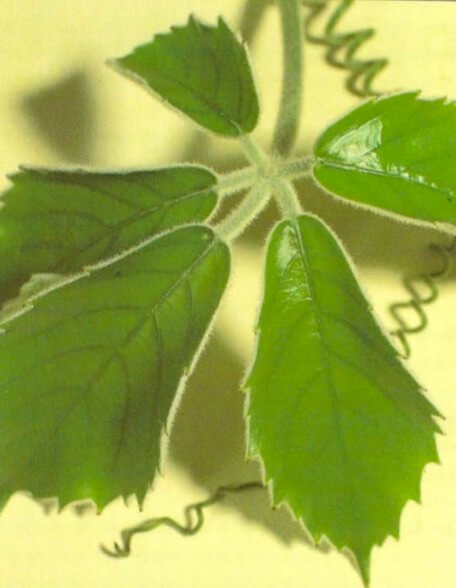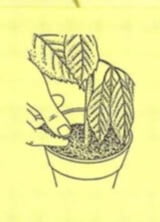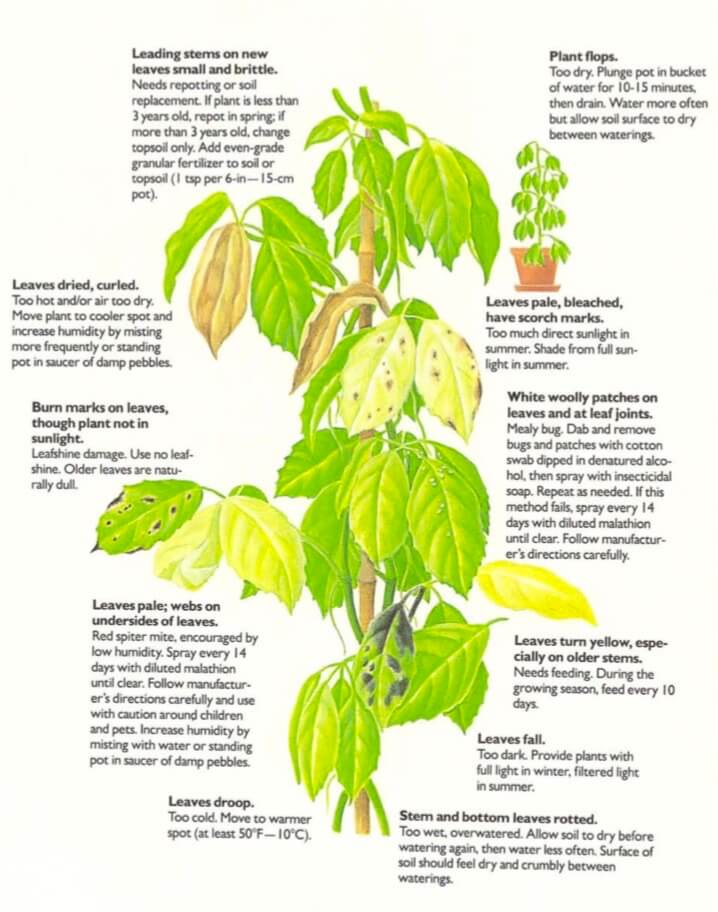[Ebook Việt Hoá] The Instant Guide to Healthy Houseplants (Hướng dẫn tức thời để chăm cây trong nhà khoẻ mạnh), Chi Tetrastigma
[Ebook Việt Hoá] The Instant Guide to Healthy Houseplants: Tetrastigma voinieranum (Chestnut vine)
- Nguồn: [Ebook Việt Hoá] The Instant Guide to Healthy Houseplants (Hướng dẫn tức thời để chăm cây trong nhà khoẻ mạnh)
- Biên tập: Dũng Cá Xinh
- Biên dịch: Team Codai.net
English
The chestnut vine is a vigorous climber that requires a lot of space to grow. In the hot, humid atmosphere it prefers, this plant may grow up to 6 feet (almost 2 m) in a year. Although it is easily cultivated, chestnut vine has two “handle with care” requirements. It must not be overwatered and its young stems, which are brittle, must be supported. If a piece of the stem snaps off, however, the plant will continue to grow and may even produce a new shoot from the broken area.

Light
Provide semi-shade in summer, full light in winter. (If plant is too large to move, provide shade with a sheer curtain.)
Temperature
In winter, keep at a temperature above 50-60°F(10-15°C). Plant tolerates high temperatures in summer if high humidity is provided.
Water
In summer, water 1-2 times a week, allowing soil to dry between waterings. In winter, keep on the dry side, watering once every 10 days, less often if temperature drops to winter minimum (50°F – 10°C).
Feeding
During the growing season, feed every 10 days with liquid houseplant food at manufacturer’s recommended strength.
Soil
Use loam-based or peat-based soil. Add an even-grade granular fertilizer to the potting soil (1 tsp per 6-in – I5-cm pot).
Repotting
Repot annually in spring for first 2 or 3 years of plant’s life. In later years, replace topsoil only.
Cleaning
Humidity misting is sufficient. Wipe dusty leaves with a feather duster. Take care not to damage young stems. Use no leafshine.
Humidity
Mist twice a week in summer, once every 14 days in winter .
Watering
Chestnut vine is susceptible to overwatering. Test soil before adding water; allow soil below the surface to dry between waterings. Never allow water to stay in the saucer for more more than 10 minutes after watering and make sure drainage holes in pot are kept clear.

What Goes Wrong

- Leading stems on new leaves small and brittle: Needs repotting or soil replacement. If plant is less than 3 years old, repot in spring; if more than 3 years old, change topsoil only. Add even-grade granular fertilizer to soil or topsoil (1 tsp per 6-in – 15cm pot)
- Plant flops: Too dry. Plunge pot in bucket of water for 10-15 minutes, then drain. Water more often but allow soil surface to dry between waterings.
- Leaves dried, curled: Too hot and/or air too dry. Move plant to cooler spot and increase humidity by misting more frequently or standing pot in saucer of damp pebbles.
- Burn marks on leaves, though plant not in sunlight: Leafshine damage. Use no leafshine. Older leaves are naturally dull.
- Leaves pale; webs on undersides of leaves: Red spider mite, encouraged by low humidity. Spray every 14 days with diluted malathion until clear. Follow manufacturer’s directions carefully and use with caution around children and pets. Increase humidity by misting with water or standing pot in saucer of damp pebbles.
- Leaves droop: Too cold. Move to warmer spot (at least 50°F – 10°C).
- Stem and bottom leaves rotted: Too wet, overwatered. Allow soil to dry before watering again, then water less often. Surface of soil should feel dry and crumbly between waterings.
- Leaves pale, bleached, have scorch marks: =Too much direct sunlight in summer. Shade from full sunlight in summer.
- White woolly patches on leaves and at leaf joints: Mealy bug. Dab and remove bugs and patches with cotton swab dipped in denatured alcohol, then spray with insecticidal soap. Repeat as needed. If this method fails, spray every 14 days with diluted malathion until clear. Follow manufacturer’s directions carefully.
- Leaves turn yellow, especially on older stems: Needs feeding. During the growing season, feed every 10 days.
- Leaves fall: Too dark. Provide plants with full light in winter, filtered light in summer.
Tiếng Việt
Cây dẻ gai là một loài cây leo mạnh mẽ và cần nhiều không gian để phát triển. Trong điều kiện không khí nóng ẩm, loài cây này có thể cao tới 6 feet (gần 2 m) trong một năm. Mặc dù là loại cây dễ trồng nhưng cây dẻ gai có hai yêu cầu “chăm sóc cẩn thận”. Không được tưới quá nhiều và các thân non của nó rất giòn nên phải được chống đỡ. Tuy nhiên, nếu một phần của thân cây bị gãy, cây sẽ tiếp tục phát triển và thậm chí có thể tạo ra chồi mới từ khu vực bị gãy.

Ánh sáng
Cung cấp bóng mát cho cây vào mùa hè, ánh sáng đầy đủ vào mùa đông. (Nếu cây quá lớn để di chuyển, hãy tạo bóng mát bằng rèm che.)
Nhiệt độ
Vào mùa đông, giữ ở nhiệt độ trên 50-60 độ F (10-15 độ C). Cây chịu được nhiệt độ cao vào mùa hè nếu độ ẩm cao.
Nước
Vào mùa hè, tưới 1-2 lần một tuần và để đất khô giữa các lần tưới. Vào mùa đông, giữ ở nơi khô ráo, tưới nước 10 ngày một lần và ít hơn nếu nhiệt độ xuống thấp nhất vào mùa đông (50 độ F – 10 độ C).
Bón phân
Trong suốt mùa sinh trưởng, bón 10 ngày một lần bằng phân bón hữu cơ theo khuyến cáo của nhà sản xuất.
Đất
Sử dụng đất mùn hoặc đất than bùn. Thêm phân bón dạng hạt vào bầu đất (1 muỗng cà phê cho mỗi chậu 6 inch – 15 cm).
Thay chậu
Thay chậu hàng năm vào mùa xuân trong 2 hoặc 3 năm đầu đời của cây. Trong những năm sau, chỉ thay lớp đất trên bề mặt.
Làm sạch
Phun sương tạo độ ẩm vừa đủ. Lau lá có bụi bằng khăn mềm. Chú ý không làm hỏng thân non. Không sử dụng xịt bóng lá.
Độ ẩm
Phun sương hai lần một tuần vào mùa hè, 14 ngày một lần vào mùa đông.
Tưới cây
Cây hạt dẻ dễ bị hư hại khi tưới quá mức. Kiểm tra đất trước khi tưới; theo dõi đất dưới bề mặt phải khô giữa các lần tưới. Không bao giờ để nước đọng trong đĩa quá 10 phút sau khi tưới và đảm bảo các lỗ thoát nước trong chậu luôn thông thoáng.

Những vấn đề có thể xảy ra

- Lá mới trên thân chính nhỏ và dễ gãy: Cần thay chậu hoặc thay đất. Nếu cây dưới 3 năm tuổi, thay chậu vào mùa xuân; nếu trên 3 năm tuổi thì chỉ thay lớp đất mặt. Thêm phân bón dạng hạt đều vào đất hoặc lớp đất mặt (1 muỗng cà phê cho mỗi chậu 6 inch – 15cm)
- Cây khô: Quá khô. Ngâm chậu trong xô nước khoảng 10-15 phút, sau đó để ráo. Tưới nước thường xuyên hơn nhưng để bề mặt đất khô giữa các lần tưới.
- Lá khô, quăn: Quá nóng hoặc không khí quá khô. Di chuyển cây đến chỗ mát hơn và tăng độ ẩm bằng cách phun sương thường xuyên hoặc đặt chậu trong đĩa sỏi ẩm.
- Vết cháy trên lá, dù cây không ở dưới ánh sáng mặt trời: Hư hại do xịt bóng lá . Không được sử dụng. Các lá già có màu xỉn tự nhiên.
- Lá nhợt nhạt; mạng nhện ở mặt dưới của lá: Nhện đỏ, xuất hiện bởi độ ẩm thấp. Phun 14 ngày một lần với malathion pha loãng cho đến khi hết. Làm theo hướng dẫn của nhà sản xuất một cách cẩn thận và thận trọng khi sử dụng xung quanh trẻ em và vật nuôi. Tăng độ ẩm bằng cách phun sương với nước hoặc đặt chậu đứng trong đĩa sỏi ẩm.
- Lá rũ xuống: Quá lạnh. Di chuyển đến nơi ấm hơn (ít nhất 50 độ F – 10 độ C).
- Thân và lá bị thối rữa: Quá ẩm ướt, bị úng. Để đất khô trước khi tưới lại, sau đó tưới ít nước hơn. Bề mặt đất phải khô và vụn giữa các lần tưới.
- Lá nhợt nhạt, phai màu, có vết cháy xém: Quá nhiều ánh nắng trực tiếp vào mùa hè. Che mát và tránh ánh sáng mặt trời đầy đủ vào mùa hè.
- Các mảng lông tơ màu trắng trên lá và ở các khớp lá: Rệp sáp. Dùng tăm bông nhúng vào cồn biến tính để loại bỏ bọ và các mảng, sau đó xịt xà phòng diệt côn trùng. Lặp lại khi cần thiết. Nếu phương pháp này không thành công, hãy phun 14 ngày một lần với malathion pha loãng cho đến khi khỏi bệnh. Làm theo hướng dẫn của nhà sản xuất một cách cẩn thận.
- Lá chuyển sang màu vàng, đặc biệt trên thân cây già: Cần bón phân. Trong mùa sinh trưởng, bón phân 10 ngày một lần.
- Lá rơi: Quá tối. Cung cấp cho cây đầy đủ ánh sáng vào mùa đông, lọc ánh sáng vào mùa hè.
![[Ebook Việt Hoá] The Instant Guide to Healthy Houseplants: Tetrastigma voinieranum (Chestnut vine) [Ebook Việt Hoá] The Instant Guide to Healthy Houseplants: Tetrastigma voinieranum (Chestnut vine)](https://vn1.vdrive.vn/codai.net/2020/02/ebook-huong-dan-tuc-thoi-cham-cay-trong-nha-khoe-manh-34-tetrastigma-voinieranum.jpg)


